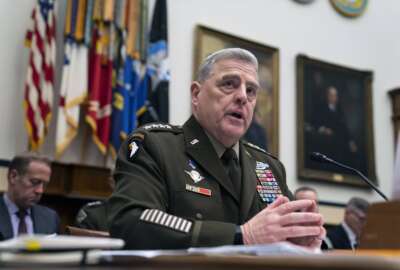
DoD tells industry how it will handle cost of inflation
The Defense Department will bear some of the cost of increased goods and services.
As the nation is still in the midst of decades-high inflation, the Defense Department is advising its industry partners on who will be shouldering the burden of increased costs in existing contracts.
The Pentagon released clarifying guidance explaining how it will specifically handle cost differences in different contract agreements.
“The current economic environment requires we understand the impacts of inflation to existing contracts and consider various approaches to manage risk of inflation to DoD contracts,” the memo signed by John Tenaglia, the principal director of defense pricing and contracting, reads. “We acquire a wide range of goods and services to fulfill the Department’s mission requirements; inflation is impacting several segments of our economy in varying degrees. Against this backdrop, DoD contractors and contracting officers alike have expressed renewed interest in using economic price adjustment (EPA) clauses.”
The National Defense Industrial Association (NDIA) stated that it appreciated DoD sharing the clarifying guidance and it looks forward to working with DoD to ensure its members’ voices are heard.
The memo makes clear that the treatment of cost increases is dependent on contract type. For cost reimbursement type contracts, the government takes on the burden of increased costs due to inflation. The memo states the contractors must notify DoD that costs incurred are approaching limits specified in the contract. The government may increase funding and the contractor is not obligated to continue performance beyond what is specified in the contract.
For fixed-price incentive contracts, DoD may adjust the contract’s target cost.
“The EPA clause normally establishes a mechanism to mitigate specifically covered cost risks to both parties as a result of industry-wide contingencies beyond any individual contractor’s control; the government will bear the cost risk up to the limit specified in the clause,” the memo states.
Firm-fixed-price contracts are another story, however. Contractors in those situations taken on the risk of increased costs. There is no authority providing help for inflation in those situations. DoD says it is taking questions about the possibility of using requests of equitable adjustment (REAs) to address inflation.
In those situations a contractor will propose an adjustment to the agreement based on the scope of the contract.
“Since cost impacts due to unanticipated inflation are not a result of a contracting officer-directed change, DoD should not agree to contractor REAs submitted in response to changed economic conditions,” the memo states.
For businesses currently negotiating contracts, DoD says the EPA can be a good tool to balance the risk between contractors and the government.
“Including an EPA clause may enable a contractor to accept a fixed-price contract without having to develop pricing based on worst case projections to cover the cost risk attributable to unstable market conditions because of the EPA clause’s built-in mechanism to mitigate such risk,” the memo states.
DoD’s memo gives guidance to contracting officers, telling them to request assistance from local pricing and policy officers and to exclude any allowances from the base contract price.
Stan Soloway, president and CEO of Celero Strategies, said the memo is a straightforward recitation of what is in current contracting rules.
“Inflation is always a tricky matter for government contracts,” he told Federal News Network. “It creates uncertain market conditions and the only way to address it is in a partner-like spirit. Companies have to recognize the government’s equities and the government has to recognize that while it is reasonable to hold companies to account for their bids, sometimes unpredictable, external factors do create circumstances where both sides need to negotiate in good faith. This memo pretty much reaffirms that.”
Soloway said companies are concerned about the cost of goods and talent as prices continue to rise.
Defense industry advocacy groups are already calling for increased military spending to hedge against inflation.
Both NDIA and the Aerospace Industries Association wrote letters to Congress to encourage funding at 3% to 5% above inflation.
Copyright © 2025 Federal News Network. All rights reserved. This website is not intended for users located within the European Economic Area.
Scott Maucione is a defense reporter for Federal News Network and reports on human capital, workforce and the Defense Department at-large.
Follow @smaucioneWFED






